Kalman Filter and Wavelet Cross-Correlation for VHF Broadband Interferometer Lightning Mapping
Abstract
1. Introduction
2. Materials and Methods
2.1. Broadband Interferometer (ITF)
2.1.1. Preprocessing
2.1.2. Time Difference of Arrival (TDOA)
2.1.3. Lightning Mapping
2.2. Hardware
2.3. Simulation
2.3.1. Generation of Azimuth and Elevation Angles
2.3.2. Derivation of Time Delay
2.3.3. Simulated ITF Signals
3. Results and discussion
3.1. Simulation Results
3.2. Real Data Results
4. Conclusions
Author Contributions
Funding
Conflicts of Interest
References
- Richard, P.; Delannoy, A.; Labaune, G.; Laroche, P. Rsults of Spatial and Temporal Charactrization of the VHF-UHF Radiation of Lightning. J. Geophys. Res. 1986, 91, 1248–1260. [Google Scholar] [CrossRef]
- Shao, X.M.I.; Krehbiel, P.R. The spatial and temporal development of intracloud lightning upward at a speed established the beginning of one or is characterized streamers that. J. Geophys. Res. 1996, 101, 26641–26668. [Google Scholar] [CrossRef]
- Thomas, R.J.; Krehbiel, P.R.; Rison, W.; Hamlin, T.; Harlin, J.; Shown, D. Observations of VHF source powers radiated by lightning. Geophys. Res. Lett. 2001, 28, 143–146. [Google Scholar] [CrossRef]
- Rison, W.; Thomas, R.J.; Krehbiel, P.R.; Hamlin, T.; Harlin, J. A GPS-based three-dimensional lightning mapping system: Initial observations in central New Mexico. Geophys. Res. Lett. 1999, 26, 3573–3576. [Google Scholar] [CrossRef]
- Zhang, Y.; Zhang, Y.; Lu, W.; Zheng, N.; Meng, Q. An analysis of the initial breakdown pulse for positive cloud-to-ground flashes. In Proceedings of the 2011 7th Asia-Pacific International Conference on Lightning, Chengdu, China, 1–4 November 2011; pp. 165–168. [Google Scholar] [CrossRef]
- Sun, Z.; Qie, X.; Liu, M.; Cao, D.; Wang, D. Lightning VHF radiation location system based on short-baseline TDOA technique—Validation in rocket-triggered lightning. Atmos. Res. 2012, 129, 58–66. [Google Scholar] [CrossRef]
- McCarthy, J. Tropic Lightning: Myth or Menace? Hawai J. Med. Public Health J. Asia Pac. Med. Public Health 2014, 73, 44–47. [Google Scholar]
- Zeng, R.; Zhuang, C.; Zhou, X.; Chen, S.; Wang, Z.; Yu, Z.; He, J. Survey of recent progress on lightning and lightning protection research. High Volt. 2016, 1, 2–10. [Google Scholar] [CrossRef]
- Stock, M.G.; Akita, M.; Krehbiel, P.R.; Rison, W.; Edens, H.E.; Kawasaki, Z.; Stanley, M.A. Continuous broadband digital interferometry of lightning using a generalized cross-correlation algorithm. J. Geophys. Res. Atmos. 2014, 119, 3134–3165. [Google Scholar] [CrossRef]
- Akita, M.; Stock, M.; Kawasaki, Z.; Krehbiel, P.; Rison, W.; Stanley, M. Data processing procedure using distribution of slopes of phase differences for broadband VHF interferometer. J. Geophys. Res. Atmos. 2014, 119, 6085–6104. [Google Scholar] [CrossRef]
- Ushio, T.; Kawasaki, Z.-I.; Akita, M.; Yoshida, S.; Morimoto, T.; Nakamura, Y. A VHF broadband interferometer for lightning observation. In Proceedings of the 2011 XXXth URSI General Assembly and Scientific Symposium, Istanbul, Turkey, 13–20 August 2011; pp. 1–4. [Google Scholar] [CrossRef]
- Kawasaki, Z. Review of the Location of VHF Pulses Associated with Lightning Discharge. Aerosp. Lab 2012, 1–7. [Google Scholar]
- Proctor, D.E. A hyperbolic system for obtaining VHF radio pictures of lightning. J. Geophys. Res. Space Phys. 1971, 76, 1478–1489. [Google Scholar] [CrossRef]
- Proctor, D.E. VHF radio pictures of cloud flashes. J. Geophys. Res. Space Phys. 1981, 86, 4041. [Google Scholar] [CrossRef]
- Lennon, C.; Maier, L. Lightning Mapping System. Light. Mapp. Syst. 1991, 91, 1–10. [Google Scholar]
- Qiu, S.; Zhou, B.-H.; Shi, L.-H.; Dong, W.-S.; Zhang, Y.-J.; Gao, T.-C. An improved method for broadband interferometric lightning location using wavelet transforms. J. Geophys. Res. Space Phys. 2009, 114, 1–9. [Google Scholar] [CrossRef]
- Warwick, J.W.; Hayenga, C.O.; Brosnahan, J.W. Interferometric Directions of Lightning Sources at 34 MHz I km. J. Geophys. Res. 1979, 84, 2457–2468. [Google Scholar] [CrossRef]
- Hayenga, C.O.; Warwick, J.W. Two-dimensional interferometric positions of VHF lightning sources. J. Geophys. Res. Space Phys. 1981, 86, 7451. [Google Scholar] [CrossRef]
- Rhodes, C.T.; Shao, X.M.; Krehbiel, P.R.; Thomas, R.J.; Hayenga, C.O. Observations of lightning phenomena using radio interferometry. J. Geophys. Res. Space Phys. 1994, 99, 13059. [Google Scholar] [CrossRef]
- Rhodes, C.; Krehbiel, P.R. Interferometric observations of a single stroke cloud-to-ground flash. Geophys. Res. Lett. 1989, 16, 1169–1172. [Google Scholar] [CrossRef]
- Mardiana, R.; Kawasaki, Z. Broadband radio interferometer utilizing a sequential triggering technique for locating fast-moving electromagnetic sources emitted from lightning. IEEE Trans. Instrum. Meas. 2000, 49, 376–381. [Google Scholar] [CrossRef][Green Version]
- Abeywardhana, R.; Sonnadara, U.; Abegunawardana, S.; Fernando, M.; Cooray, V. Lightning Localization Based on VHF Broadband Interferometer Developed in Sri Lanka. In Proceedings of the 2018 34th International Conference on Lightning Protection (ICLP), Rzeszow, Ploland, 2–7 Serptember 2018; pp. 1–5. [Google Scholar] [CrossRef]
- Bishop, G.; Welch, G. An introduction to the kalman filter. Proc. SIGGRAPH Course 2001, 8, 41. [Google Scholar]
- Zorzi, M. Robust Kalman Filtering under Model Perturbations. IEEE Trans. Autom. Control. 2016, 62, 1. [Google Scholar] [CrossRef]
- Pan, Q.; Zhang, K.; Dai, G.; Zhang, H. Two denoising methods by wavelet transform. IEEE Trans. Signal Process. 1999, 47, 3401–3406. [Google Scholar] [CrossRef]
- Matrix Labratory software (MATLAB); Version 2019b; The MathWorks: Natick, MA, USA, 2019.
- Mohammad, S.A.; Ahmad, M.R.; Alkahtani, A.A. The Evaluation of Parallel Plate Antenna with Variation of Air Gaps Separation and Copper Plate Area. TEST Eng. Manag. Mag. 2019, 81, 5663–5670. [Google Scholar]
- Sabri, M.; Ahmad, M.R.; Esa, M.; Periannan, D.; Lu, G.; Zhang, H.; Cooray, V.; Williams, E.; Aziz, M.; Abdul-Malek, Z.; et al. Initial electric field changes of lightning flashes in tropical thunderstorms and their relationship to the lightning initiation mechanism. Atmos. Res. 2019, 226, 138–151. [Google Scholar] [CrossRef]
- Picoscope 6 PC oscilliscope software; Version: 6.13.14.4049; Pico Technology Ltd.: Cambs, UK, 2018.



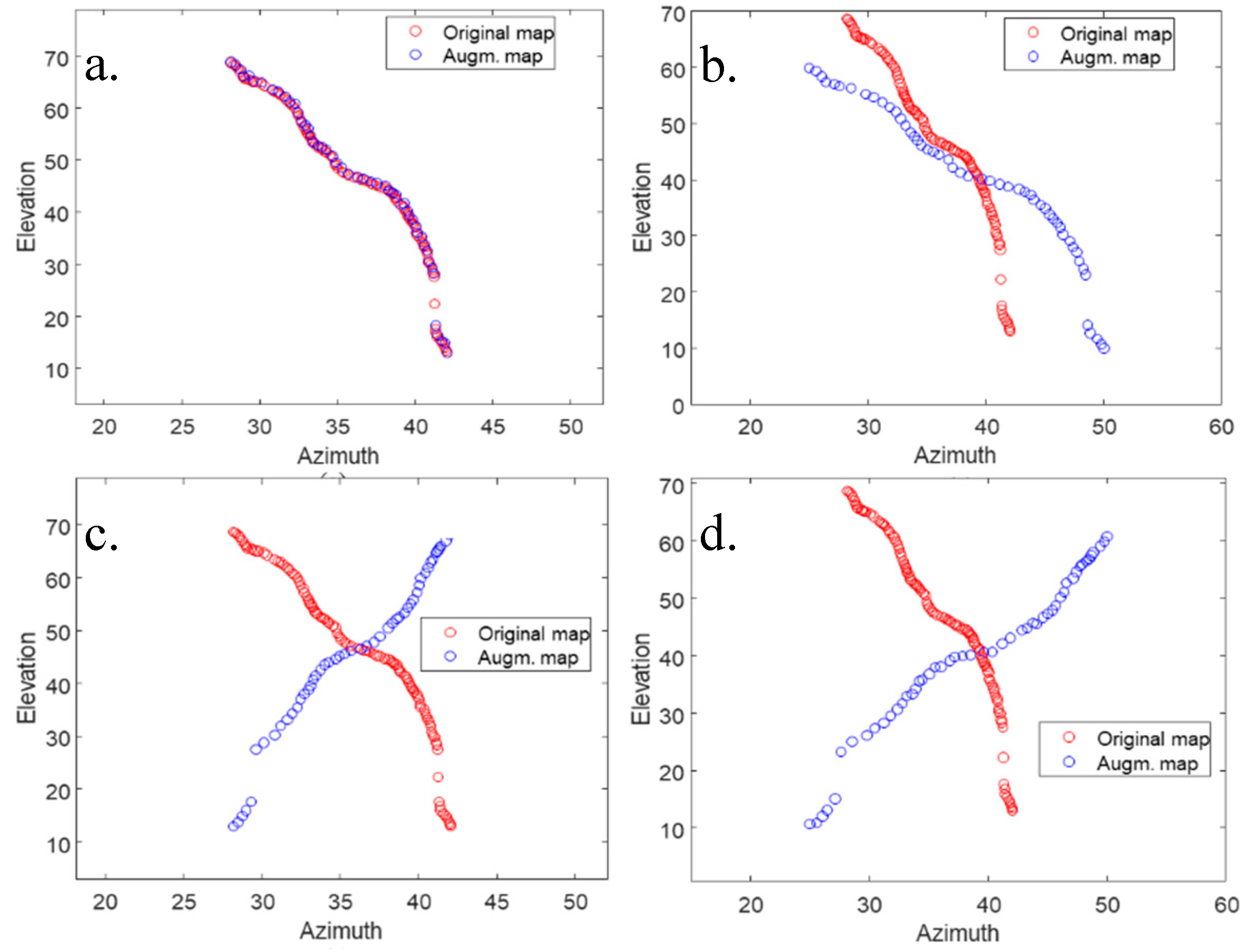

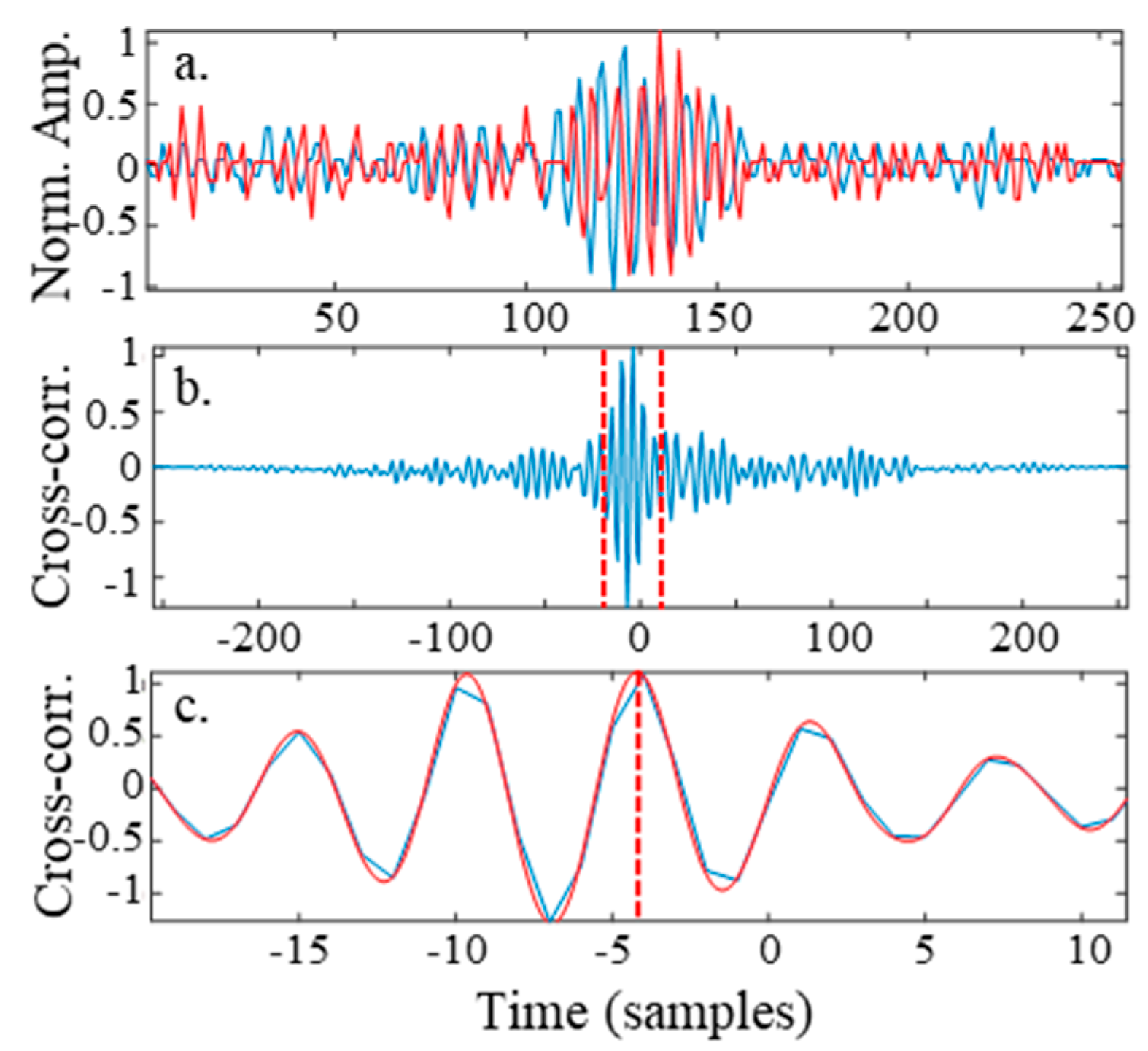
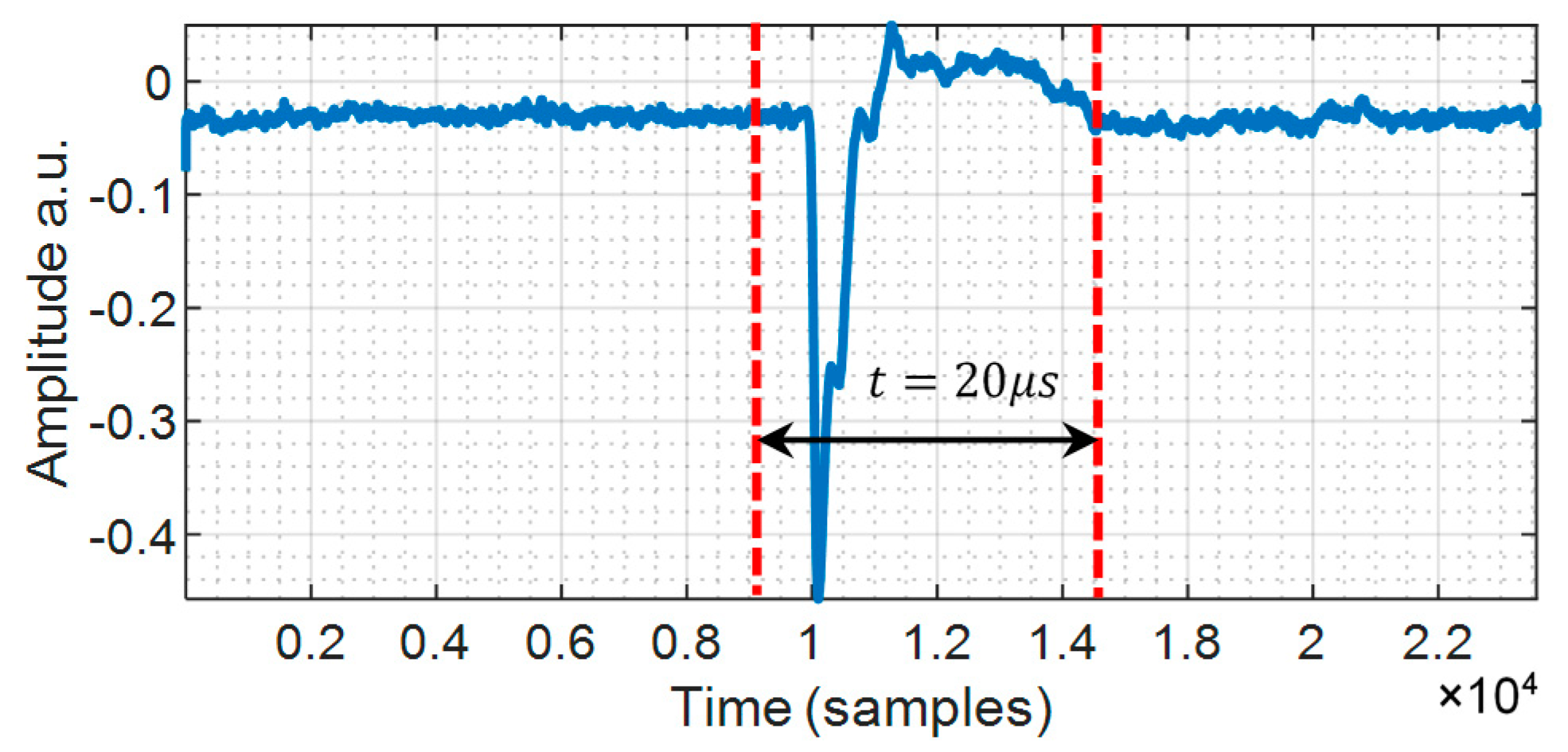
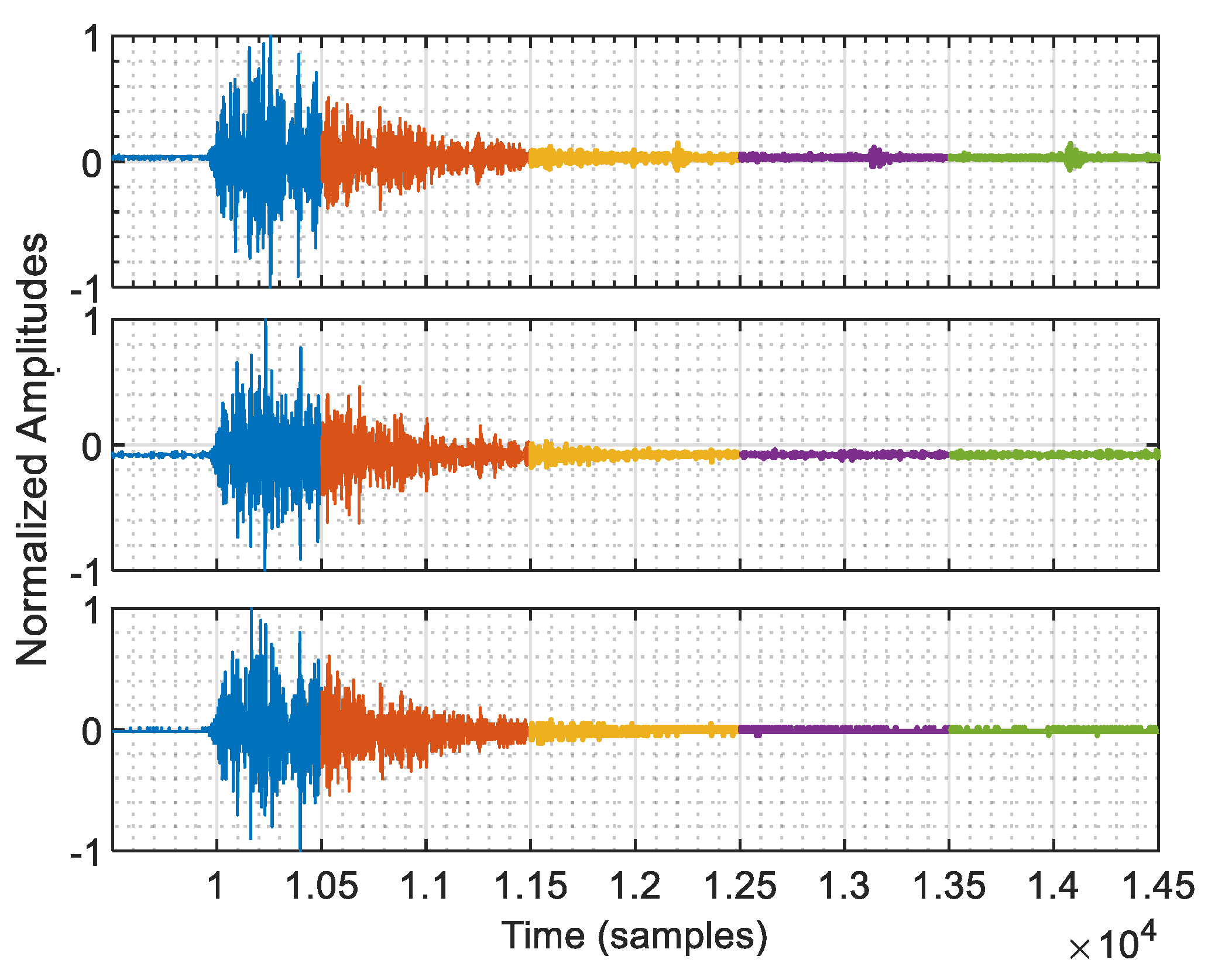
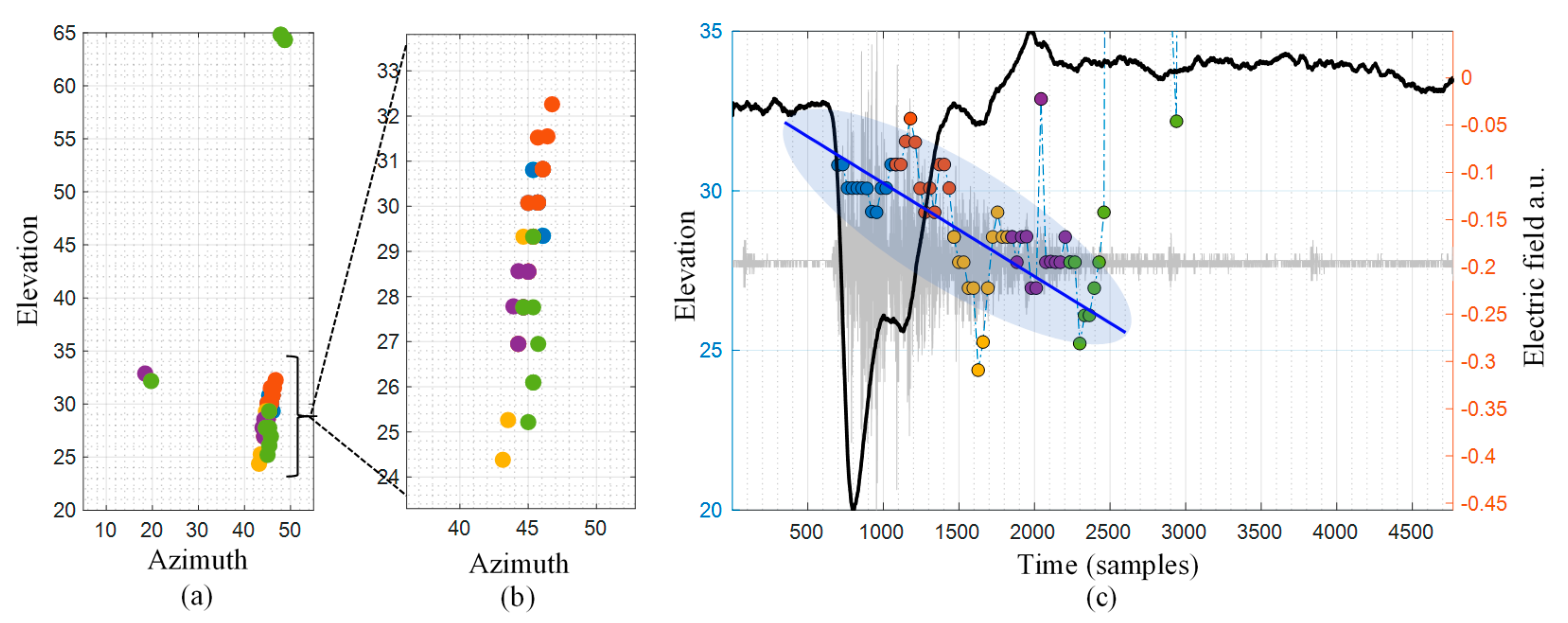
| Parameters | Description |
|---|---|
| Sample interval | 4 ns |
| Sampling Rate of VHF | 250 MS/s |
| No of samples | 52,000,002 |
| Number of Antennae | 3 |
| Signal band-limited | 40–80 MHz |
| Centred Frequency | 60 MHz |
| Distance between antennae | 15 m baseline |
| Picoscope | Picoscope 3000 (3405D) |
| Correlation Method | CCTD | CCFD | CCWD | |||||||||||||||||||||
|---|---|---|---|---|---|---|---|---|---|---|---|---|---|---|---|---|---|---|---|---|---|---|---|---|
| Interp. Method | Linear | Cubic | Linear | Cubic | Linear | Cubic | ||||||||||||||||||
| Interp. Factor | 1 | 2 | 4 | 8 | 1 | 2 | 4 | 8 | 1 | 2 | 4 | 8 | 1 | 2 | 4 | 8 | 1 | 2 | 4 | 8 | 1 | 2 | 4 | 8 |
| WT-Coif5-SURE | 4.08 | 3.99 | 4.04 | 4.10 | 4.08 | 4.16 | 4.10 | 4.08 | 4.08 | 4.35 | 4.53 | 4.60 | 4.08 | 4.16 | 4.10 | 4.08 | 3.65 | 3.90 | 3.86 | 4.76 | 3.65 | 4.80 | 4.78 | 4.75 |
| WT-Coif-UNIVERSAL | 8.54 | 8.23 | 8.24 | 8.29 | 8.54 | 8.40 | 8.37 | 8.35 | 8.54 | 8.65 | 8.85 | 8.95 | 8.54 | 8.40 | 8.37 | 8.35 | 11.22 | 11.51 | 11.84 | 12.65 | 11.22 | 12.67 | 12.62 | 12.59 |
| WT-db10-SURE | 4.19 | 4.10 | 4.08 | 4.16 | 4.19 | 4.10 | 4.07 | 4.03 | 4.19 | 4.41 | 4.47 | 4.55 | 4.19 | 4.10 | 4.07 | 4.03 | 3.85 | 3.89 | 3.79 | 4.62 | 3.85 | 4.57 | 4.57 | 4.54 |
| WT-db10-UNIVERSAL | 9.10 | 8.98 | 9.05 | 9.12 | 9.10 | 9.03 | 9.00 | 8.97 | 9.10 | 9.15 | 9.27 | 9.32 | 9.10 | 9.03 | 9.00 | 8.97 | 11.39 | 11.66 | 11.59 | 12.23 | 11.39 | 12.21 | 12.23 | 12.19 |
| WT-FK14-SURE | 4.06 | 3.96 | 3.95 | 4.02 | 4.06 | 3.99 | 3.96 | 3.94 | 4.06 | 4.30 | 4.37 | 4.44 | 4.06 | 3.99 | 3.96 | 3.94 | 3.98 | 4.10 | 3.92 | 4.80 | 3.98 | 4.80 | 4.68 | 4.65 |
| WT-FK14-UNIVERSAL | 9.30 | 9.24 | 9.35 | 9.44 | 9.30 | 9.26 | 9.24 | 9.22 | 9.30 | 9.34 | 9.47 | 9.53 | 9.30 | 9.26 | 9.24 | 9.22 | 12.40 | 12.47 | 12.30 | 12.96 | 12.40 | 12.85 | 12.95 | 12.92 |
| WT-Sym4-SURE | 4.06 | 3.97 | 4.00 | 4.07 | 4.06 | 4.11 | 4.07 | 4.03 | 4.06 | 4.36 | 4.50 | 4.62 | 4.06 | 4.11 | 4.07 | 4.03 | 3.46 | 3.74 | 3.71 | 4.59 | 3.46 | 4.62 | 4.57 | 4.51 |
| WT-Sym4-UNIVERSAL | 10.46 | 10.18 | 10.17 | 10.23 | 10.46 | 10.31 | 10.31 | 10.27 | 10.46 | 10.60 | 10.72 | 10.84 | 10.46 | 10.31 | 10.31 | 10.27 | 11.84 | 12.22 | 12.37 | 13.16 | 11.84 | 13.20 | 13.14 | 13.10 |
| BPF | 3.76 | 3.63 | 3.77 | 3.85 | 3.76 | 3.83 | 3.80 | 3.76 | 3.76 | 3.97 | 4.17 | 4.27 | 3.76 | 3.83 | 3.80 | 3.76 | 3.76 | 3.86 | 3.76 | 4.62 | 3.76 | 4.62 | 4.59 | 4.54 |
| KF | 3.59 | 3.55 | 3.65 | 3.84 | 3.59 | 3.71 | 3.80 | 3.61 | 3.59 | 3.89 | 4.07 | 4.25 | 3.59 | 3.71 | 3.80 | 3.61 | 3.47 | 3.78 | 3.68 | 4.55 | 3.47 | 4.53 | 4.51 | 4.48 |
© 2020 by the authors. Licensee MDPI, Basel, Switzerland. This article is an open access article distributed under the terms and conditions of the Creative Commons Attribution (CC BY) license (http://creativecommons.org/licenses/by/4.0/).
Share and Cite
Alammari, A.; Alkahtani, A.A.; Ahmad, M.R.; Noman, F.; Mohd Esa, M.R.; Sabri, M.H.M.; Mohammad, S.A.; Al-Khaleefa, A.S.; Kawasaki, Z.; Agelidis, V. Kalman Filter and Wavelet Cross-Correlation for VHF Broadband Interferometer Lightning Mapping. Appl. Sci. 2020, 10, 4238. https://doi.org/10.3390/app10124238
Alammari A, Alkahtani AA, Ahmad MR, Noman F, Mohd Esa MR, Sabri MHM, Mohammad SA, Al-Khaleefa AS, Kawasaki Z, Agelidis V. Kalman Filter and Wavelet Cross-Correlation for VHF Broadband Interferometer Lightning Mapping. Applied Sciences. 2020; 10(12):4238. https://doi.org/10.3390/app10124238
Chicago/Turabian StyleAlammari, Ammar, Ammar A. Alkahtani, Mohd Riduan Ahmad, Fuad Noman, Mona Riza Mohd Esa, Muhammad Haziq Mohammad Sabri, Sulaiman Ali Mohammad, Ahmed Salih Al-Khaleefa, Zen Kawasaki, and Vassilios Agelidis. 2020. "Kalman Filter and Wavelet Cross-Correlation for VHF Broadband Interferometer Lightning Mapping" Applied Sciences 10, no. 12: 4238. https://doi.org/10.3390/app10124238
APA StyleAlammari, A., Alkahtani, A. A., Ahmad, M. R., Noman, F., Mohd Esa, M. R., Sabri, M. H. M., Mohammad, S. A., Al-Khaleefa, A. S., Kawasaki, Z., & Agelidis, V. (2020). Kalman Filter and Wavelet Cross-Correlation for VHF Broadband Interferometer Lightning Mapping. Applied Sciences, 10(12), 4238. https://doi.org/10.3390/app10124238







